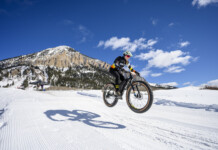By Art O’Connor — The Iditarod Trail Invitational is the human powered version of the famous Iditarod Sled Dog race. Competitors can choose to bike, walk, or ski the route. The ITI follows the same trail as the dogs, but we leave a week before they do. For us two legged competitors there are 2 distance options. The 350 or the full 1000 miles. In order to do the 1000, you must first complete the 350.
As a rookie, the 350 was my only option and believe me, I was intimidated enough by that distance. The race itself is semi self-supported. There are checkpoints along the way that have food and lodging options. Some are free others you pay out of pocket. Riders are expected to carry all the gear they think they will need to make the trek. Unlike most races that have a required gear list the ITI does not have one. Competitors are free to pack as light or as heavy as they feel comfortable doing. The guys gunning for the win go really light and really don’t stop to sleep. I was hoping to finish in under 5 days and definitely planned on sleeping.
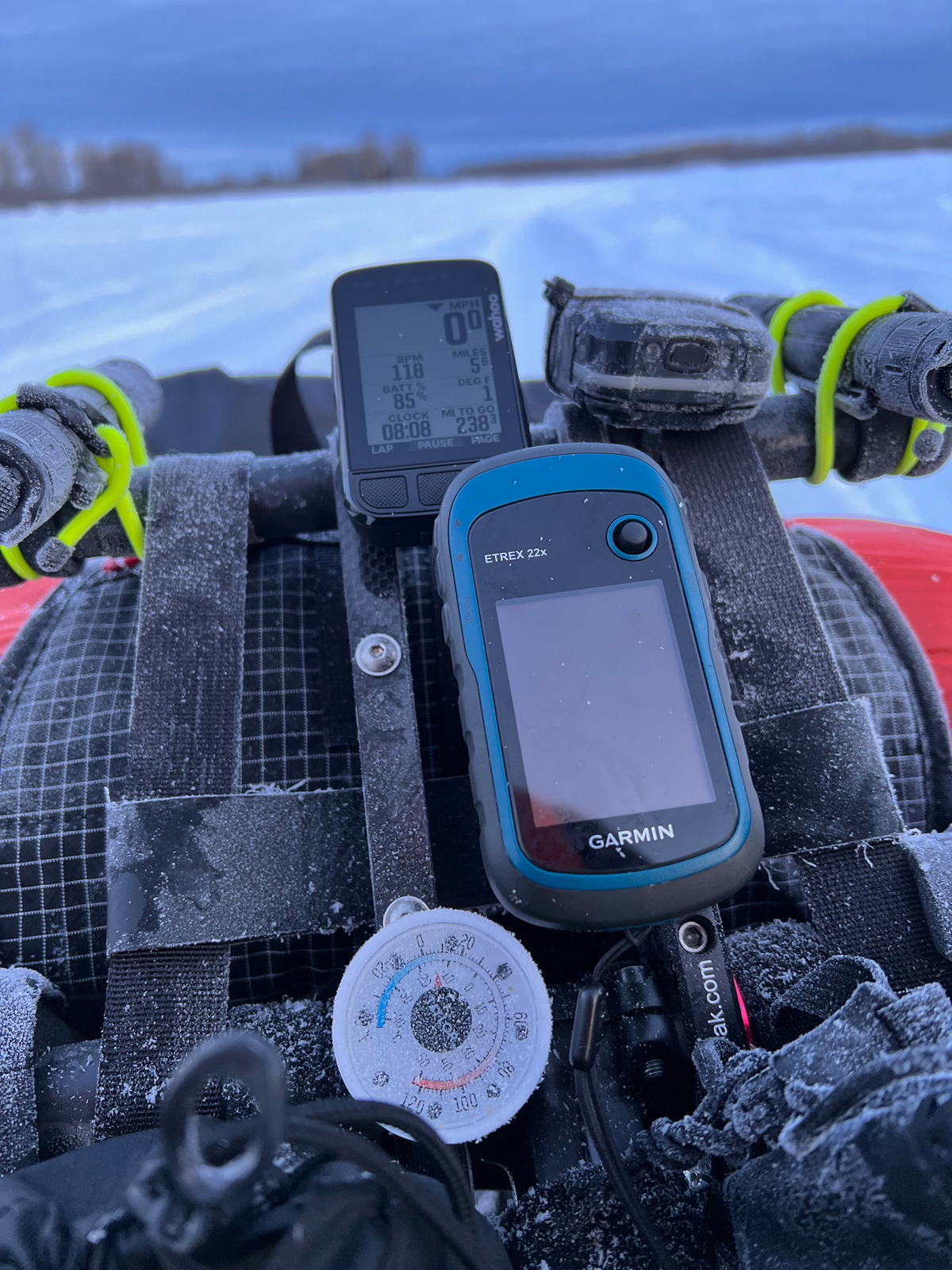
As a rookie I definitely packed for my fears. I had redundancies for my redundancies. I never weighed my bike, but I would guess I was in the 75-80lb range. The fast guys were more like 40. The race bible and the pre-race meeting are pretty clear that if you get in trouble, you had better be prepared to self-rescue.
It’s not that the race organization won’t help if you’re in trouble, but more of an expectation that they may not be able to help given the huge amount of ground the course covers and the extremes of Alaskan weather. Even if you hit the rescue button, help could be days away. This event is invitation only. You must have finishes in qualifying events and demonstrate that you have the ability to handle yourself in extreme conditions. You can’t buy your way into this race. So, understanding that explains why no required gear list. If you are coming to Alaska, you better be ready for whatever it decides to throw at you. Given that I felt more comfortable packing for my fears than embracing my inner weight weenie.
I have always had a fascination with winter expeditions and the Arctic. I have read all the Jack London tales, books about Shackleton, and the insane Twight, Krakauer, and Messner stories. I have always wanted to do something like that and see if I could test myself to my limit. Not being a climber or really having any interest in becoming one this seemed like my best shot. With 4 Fat Pursuits (two 50k and two 200k’s) under my belt and one of Jay Petervary ‘s Fat Camps under my belt I sent in my application. In July of 2021 I got the email that I was in. Holy moly, this is happening!
I got to Anchorage 3 days before the Sunday start. I wanted some time alone to get my head ready for what was to come. My old friend and former Utahn Tom Miller was flying in on Friday from Canada and I was looking forward to catching up with him, but I was really happy to have some alone time in the hotel room to get myself sorted. Events like this are more of a mental challenge than a physical one IMHO. Months of talking about it and planning it were over. Time to act now. I spent those days telling myself that no matter what happened I would finish. I would not panic. I would be grateful, and I would finish. I did have a performance goal in mind, but the primary objective was to finish.
The big topic on everyone’s mind was overflow. Overflow is when the ice cracks on the lakes and rivers and water comes up between the ice and the snow covering it. Lots of pics and videos in the days before showed knee deep water on the lakes. One other unique thing about ITI is that there is no official course map or GPX file given to the racers. Navigation is part of the skill set and the experience of ITI. The first 30-50 miles of the race usually cross several lakes that are usually frozen solid. Unusually warm temperatures had changed that. So now the challenge was finding alternative routes around the soggiest sections. I had several routes loaded on the Gaia app but if I am being honest, I was scared shitless of getting lost. More on that later.
The race starts with a 90-minute bus ride to Knik Lake for a 2pm grand départ. As the school bus rattled down the road to everyone was pretty quiet and focused on the task at hand. At the start Tom and I connected with Jenny and Jason Hanson from Arizona. We all did Fat Camp and Fat Pursuit together and it was reassuring knowing other people in the race. We got a start line pic and sent it to our friend Andy who was supposed to be with us but had to pull out after having back surgery right after Fat Pursuit.
I got a spot near the front and in front of all the walkers and skiers. When the gun went off, I settled into a good pace and found myself in a nice group of locals and race veterans. About an hour in as we were flying through some rollers, I carried a lot more momentum into a hill than the guy in front of me. This resulted in me hitting brakes to avoid hitting him and tipping over while still clipped in.
Low speed crashes are always where I get hurt. Today was no exception. My left knee was wrenched pretty good, and I found myself pedaling with one leg. Peachy. I settled back into a good pace despite my knee and was with a guy who had done the race before and knew the way around the overflow. This relieved a lot of my concerns about navigation even if it meant going harder than I wanted to.
We made it to the first checkpoint at Butterfly Lake just before dark. The trail was mostly good with minimal walking and no overflow! My new friend and I ate some soup, topped off our water and hit the trail in short order. From here on we had really good trail. My knee was not great, but I kept my mind off it and kept pace with my partner.
The next checkpoint was Yentna Station. I had originally hoped to make it past that to Skwentna on the first day. When we rolled into Yentna around midnight I made the choice to buy a meal and a bed in the hopes of giving my knee some relief. After a grilled cheese and soup, I hit the pillow around 1 am and was instantly sound asleep. When my alarm went off at 5:30 it took me a minute to remember where I was.
I rolled out of Yentna around 6:30am in the dark with Tom. Today was going to be mostly river miles for which my knee was thankful. On the flats it was not too bad, and I had plenty of Ibuprofen to take the edge off. Tom and I ride at different paces so I was alone for a while until a friendly guy name Matt caught up with me after I veered off course for a short time. He and I were about the same speed, and it was nice to have the company. We made it to Skwentna around lunch time to crush the best lasagna I think I have ever eaten.
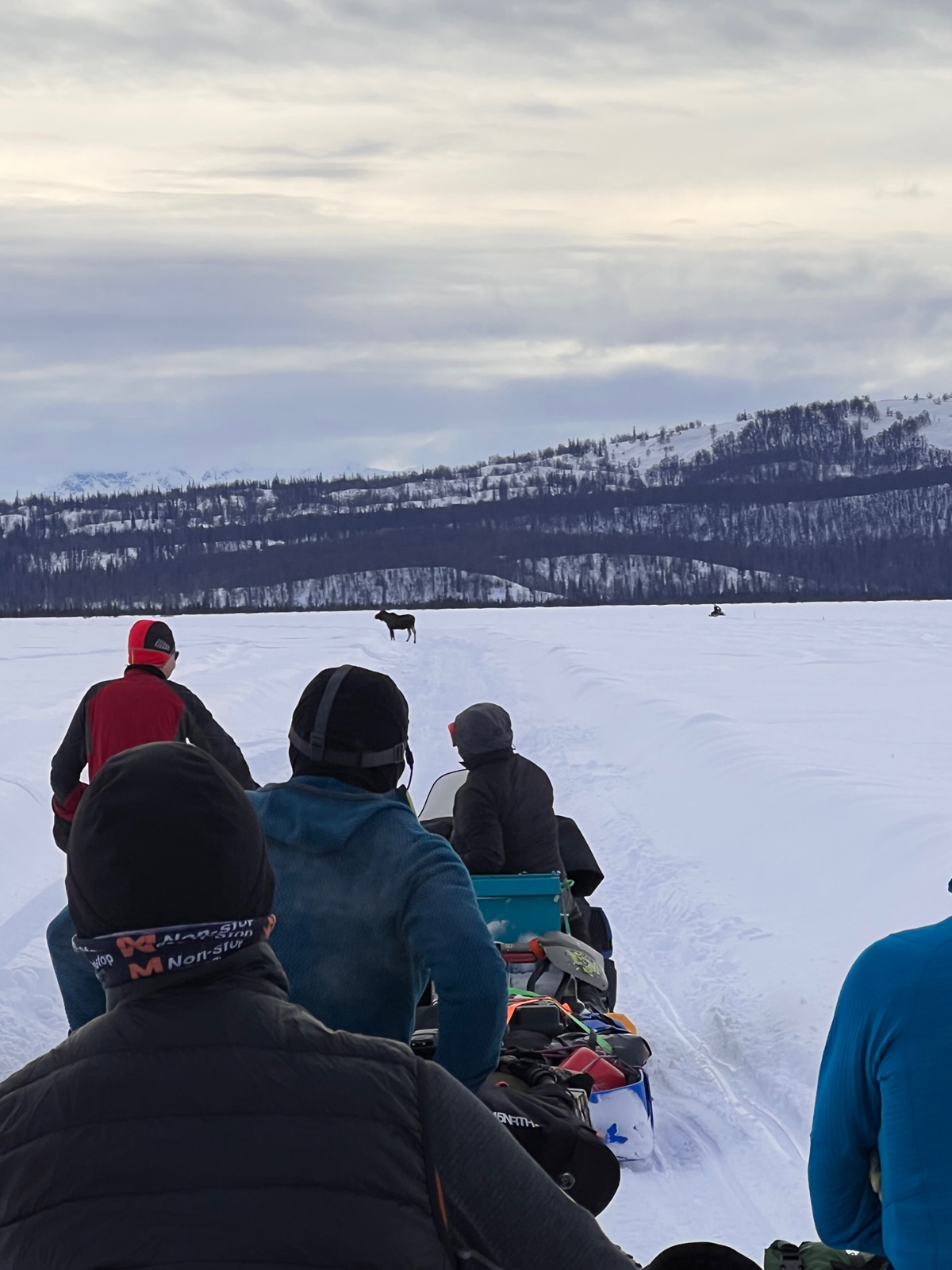
Shortly after leaving Skwentna, we entered a huge valley. Matt told me this is where the real Iditarod starts. We would be leaving the easy river miles and entering the Alaska Range which we could see in the distance. Not long after that we came upon a group of riders who stopped for a moose in the trail. Moose are the most dangerous animal that we will see in this race. With the snow they WILL NOT get off the trail. A week prior there was a much talked about story of a musher who got stomped in this same area. Before long there were about 20 of us waiting for this moose and trying to figure out how we would get around it. Stepping off the trail meant sinking up to your waist while trying to push a 75lb bike. No wonder the moose wouldn’t get off for us! The race director arrived on a snowmobile and tried to scare it off the trail. No luck. At one point it laid down in the trail and the race director launched his drone to get it to move. It did move. Towards us! A warning shot from a pistol thankfully stopped the charge. We had no choice but to try and push this moose down the trail to an intersection to get around it.
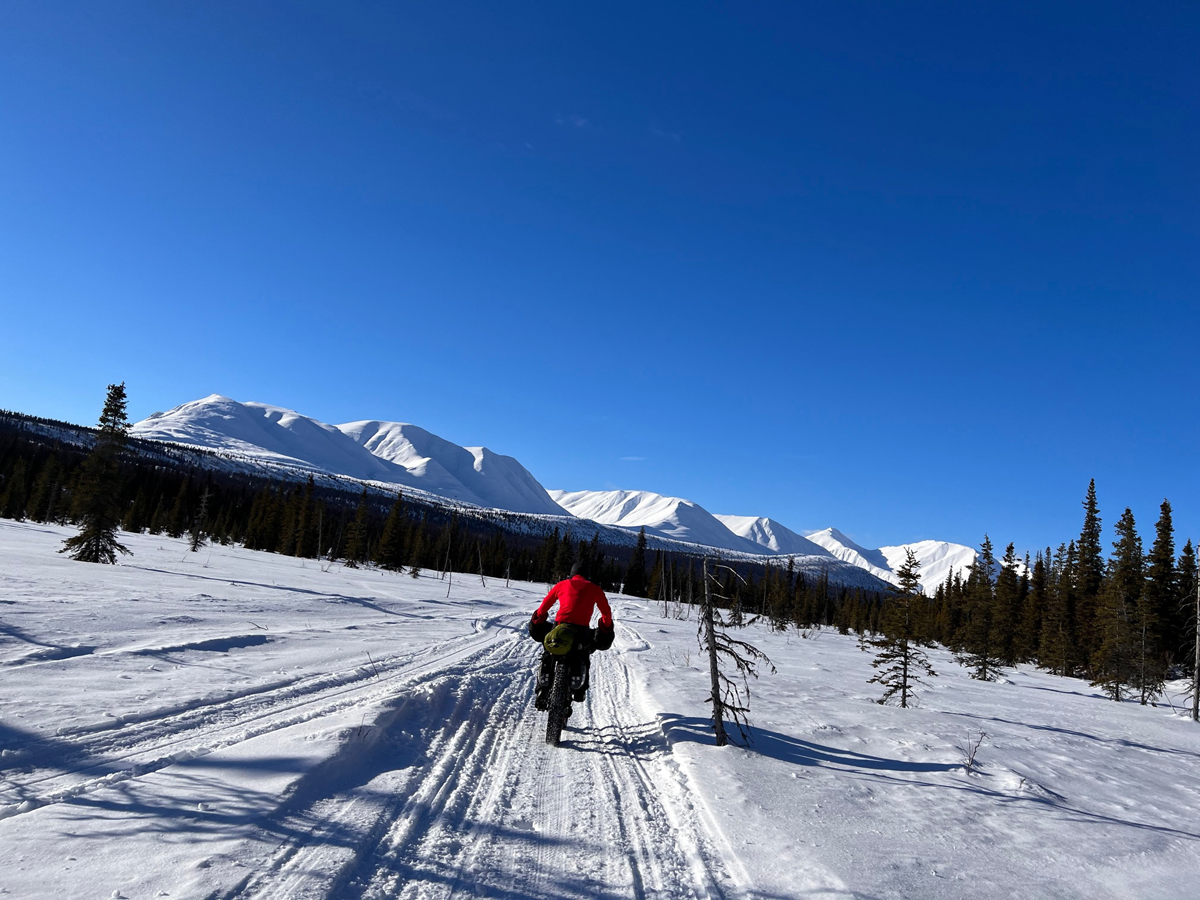
Two hours later we finally had clear trail. We were running out of daylight and were told the next checkpoint stopped serving dinner at 7 o’clock! Needless to say, our pace got pretty aggressive. We rolled into Shell Lake at 7pm. The bar owner was actually really happy to see us and to hear that a bunch more were behind us. Everyone got a warm meal! While the bar owner made a great meal and was extremely nice his trail reports were uh, suspect. He told us to get ready for the fastest best trail we have seen yet. The next checkpoint, Finger Lake, was only 3 hours away. Matt and I decided to head out knock off some easy miles. Well, 6 hours later, and a lot of walking we rolled into Finger Lake. Today was 18 hours and would be my longest push of the trip. I was tired but happy.
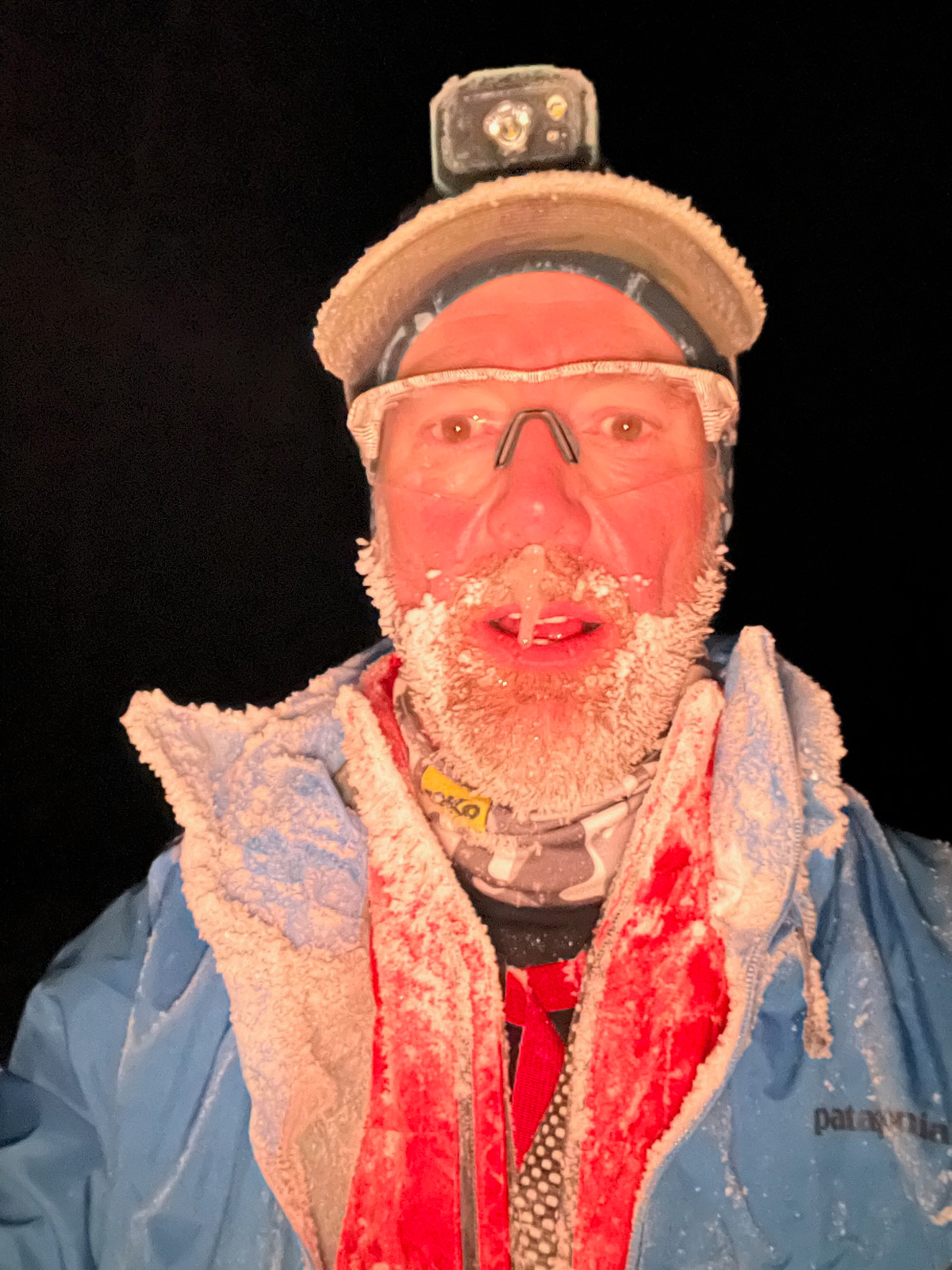
Another 5am wake up and we were back on the trail to Rainey Lodge. We were deep in the Alaska Range now and the easy river miles were a fading memory. My knee was really pissed, and I had to walk hills that I would normally ride. As much discomfort as I was in today was the most beautiful and powerful part of the course for me. The Alaska Range is spectacular, and I was feeling so humbled to be able to see it in this way. I am not a religious man, but I really felt blessed. I was glad to have Matt with me. He was having his own physical issues, but we never spoke of it.
Also, he knew a way around the infamous butt slide that precedes the Happy Steps. It is a descent so steep you can’t ride it. The technique is to hold your bike in front of you as you slide down on your butt. I was glad to miss that. The Happy Steps are what take you up from a brief section of the Skwentna River. Riding them is definitely not an option. Steeper than the steepest section of Puke Hill on the Wasatch Crest Trail in Salt Lake City, and about 800 meters long.
Basically, you push your bike in front of you. Grab the brakes, take a few steps up and repeat. It is that steep. We had caught up to 2 more riders at that point and we were all talking about the steak dinner waiting at Rainy Pass Lodge. I was in a really bad way, physically this would be my hardest day. I never considered stopping but I was fighting for every inch of forward progress. We rolled into Rainy Pass Lodge around 5pm. I was so happy to get off the bike that day. Dinner wasn’t steak but it was amazing. BBQ Ribs and Chicken. I normally don’t like meat on the bone but on this day, I think an ant would have starved if they found my plate of bones.
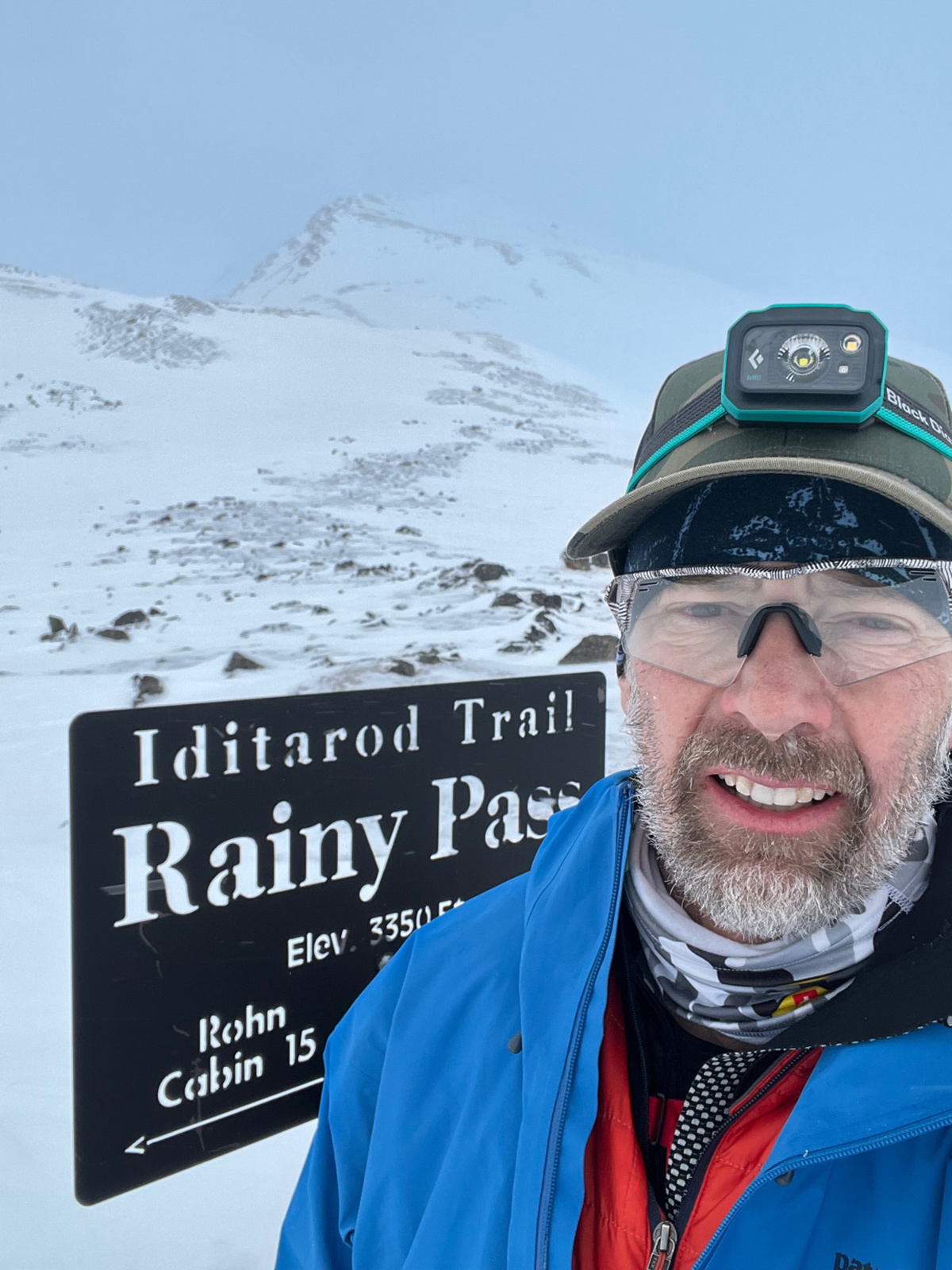
I was planning full night’s sleep here but reports of a storm coming meant another 4am alarm. Today we would hit the high point of the course, Rainy Pass. The trail here is exposed and prone to being blown in. I wanted to avoid that if possible. I set out alone into dark as it was just starting to snow. The first part of the climb was good going and even with my bum knee I was able ride most of it. The flat section after that which connects to the final climb though was a soft mess made worse by a group of snowmobilers who passed me earlier. Lots of walking.
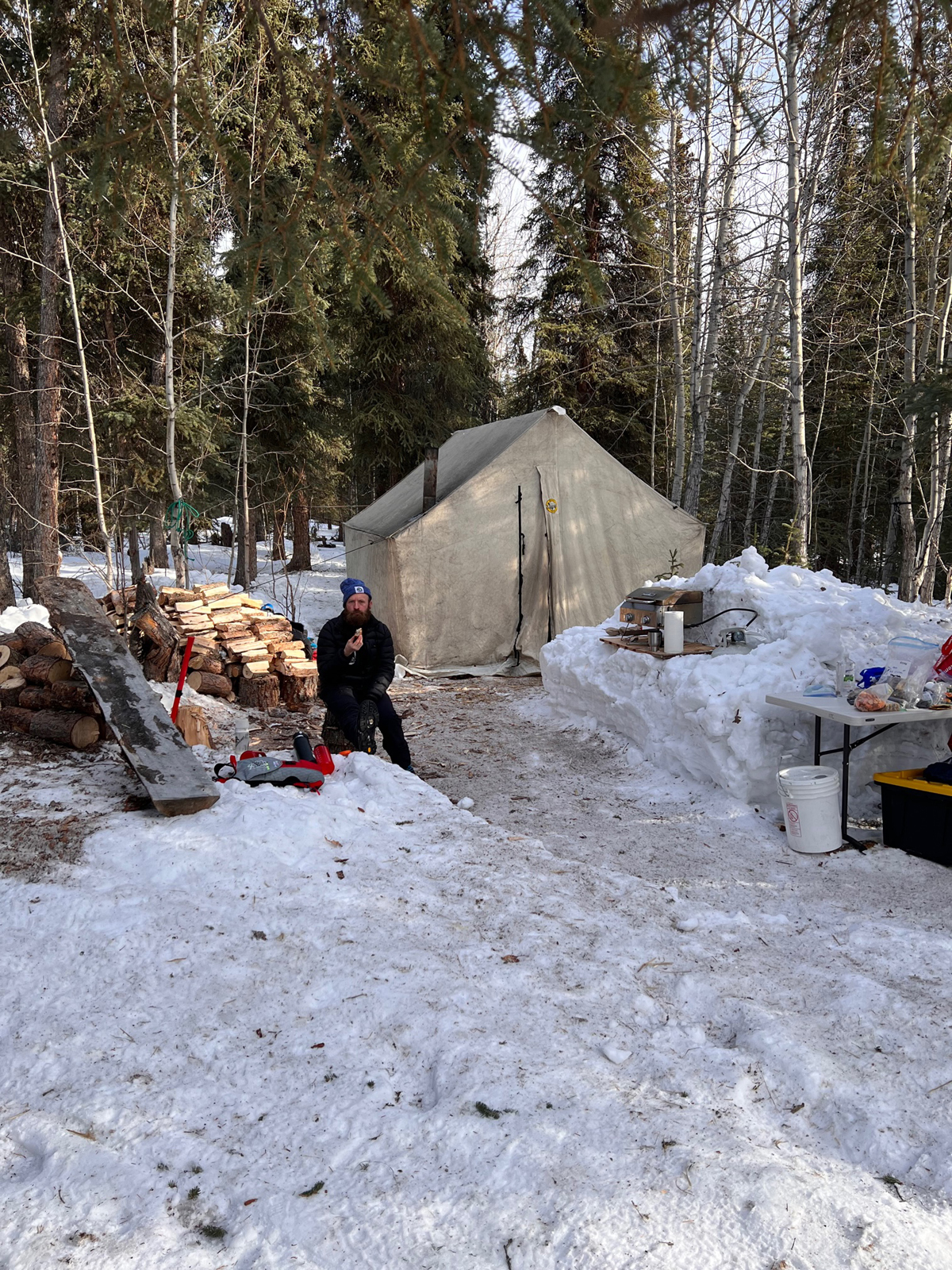
This section though was amazing. It looked like a scene out of Game of Thrones. I was expecting White Walkers at any minute! There were also hundreds of ptarmigans in the area. In the low light I could not see them since they are white, but I could sure hear them! Their weird call only added to the surreal landscape. I reached the summit around 10:30am. Took the obligatory selfie and bike leaning on the sign picture and then began my descent to Rohn, the next checkpoint. It was slow going at first as the trail was soft and blown in. Once I got into the trees though I had some of the most fun trail of the trip. I saw a few moose, well off the trail thankfully, and rolled into Rohn. Around 2:30pm I met up with Matt again. We also caught up with his sister Janice. After eating as much as I could and filling my thermos and hydration pack, we set out again with another guy I had ridden with a bit, Rob.
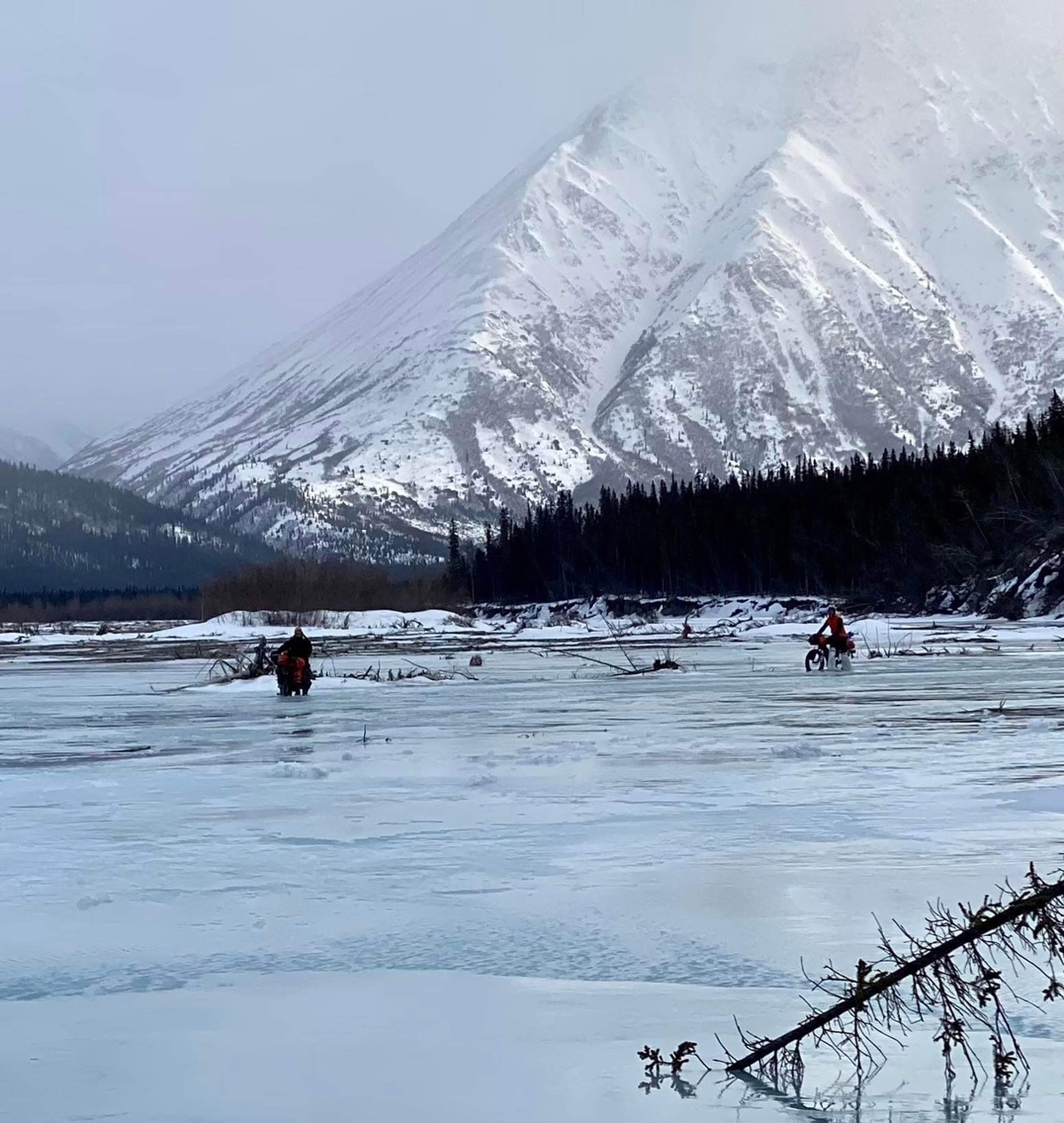
From Rohn to Nicolia would be the longest stretch between checkpoints. 80ish miles. Immediately after leaving Rohn, we faced the scariest part of the ride for me. We finally had real overflow to deal with on the Tatina River. Up to that point we were delighted with the fast, good ice on which we were riding. Just as we were within sight of where we would depart the river, we lost the good ice. We were looking at crossing 100 meters or so of what looked like open water. I was freaking out internally trying to hold it together. Matt and Janice having done this race a bunch knew this was no big deal. We all put our waders on. And I watched as Rob took the lead and waded across the open water. He made it across. Hell yes.
Now I just mentioned waders. Well, somehow, I managed to leave mine in the bunkhouse that morning, so my waders were 2 trash compactor bags that I thankfully packed as a SHTF situation (one is none 2 is one). I was not super confident they would make it across without tearing. So here I am walking SLOWLY across knee deep water on top of ice that I could hear and feel cracking under the combined weight of me and my bike. I am sure that was the highest heart rate I had the entire ride. I did make it across, and the bags held. Hail Odin!
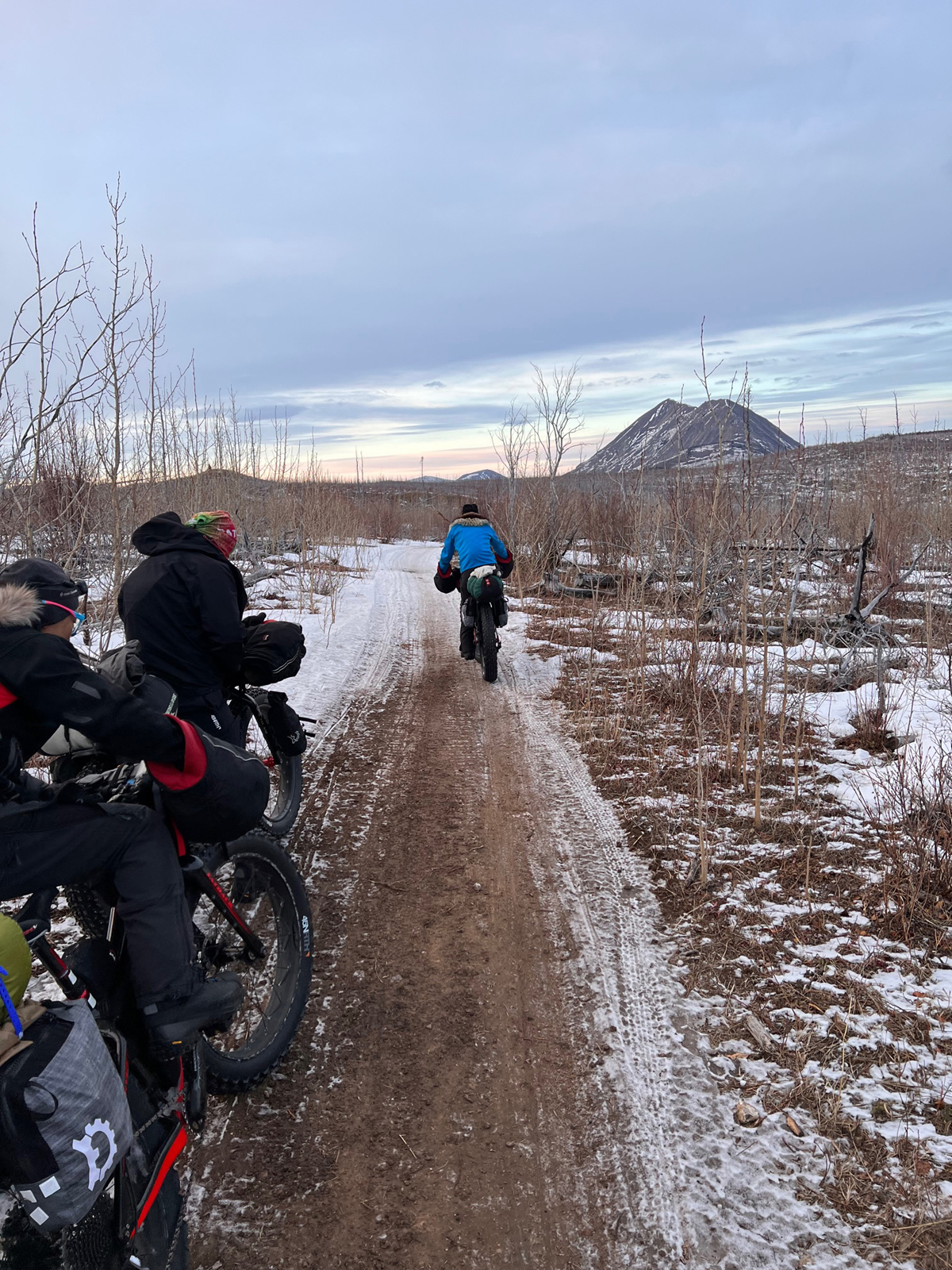
The next section of trail is known as the Farewell Burn. The site of a huge wild fire in 2009, it still has not fully recovered. This section of trail is noted for not having much snow. We had long stretches of dirt trail. There is also a wild bison herd in the area. We did not see any but saw plenty of dung! We also had a big tailwind, so we were making really good time, for now. This would be the only night I would have to bivy. As we got deeper into the Burn, we started looking for a place to camp for the night. Around midnight we did find a low spot out of the wind and set up camp.
We all set out around 7am the next morning. My knee had taken a turn for the worse as did the trail. The Irondog Snowmobile race had used this same trail a few days prior. Apparently, what the leaders do is when they get in the trees where they can’t be seen they stop and do a burn out. A lot of them. The result is an 18” trench where the track was and huge squared off mounds of snow between them. The do this to slow down the riders behind them. Nice sportsmanship huh?
Anyway, I was unable to pedal over these mounds and found myself wishing all manner of plague and pestilence on the snowmobilers. I would guess I walked 12-20 miles that day. There is nothing in this section of trail in terms of support or villages. There is Sullivan Creek though, which has a drinkable creek with a bridge over it. My plan was to make it there and then cook a meal. I arrived around 3pm and had a nice little feast of freeze-dried Shepard Pie and some tea. Miraculously the trail began to improve here and I made it to Nicolai around 7pm.
At Nicolai I smashed down 2 massive cheeseburgers. This would be the last checkpoint before the finish in McGrath, only 40 miles to go! We had free indoor sleeping at the community center in Nicolai. I set my alarm for 3am and slept like a log. I set out at 3:30 after a bowl of oatmeal and ramen. It was pretty windy and with mostly river miles to go the trail was getting blown in. I was not worried about getting lost, but I was hoping to make a better pace. I rode this entire section alone. I spent the time thinking about how far I had come. The amazing people I met. How much discomfort I dealt with. It was a mix of being relieved to be almost done, and yet wishing it would never end. I missed my wife; I missed my dog. Still though, part of me wanted to keep going. This entire trip I was more present than at any other time in my life. The days are remarkably simple. Wake up and ride.
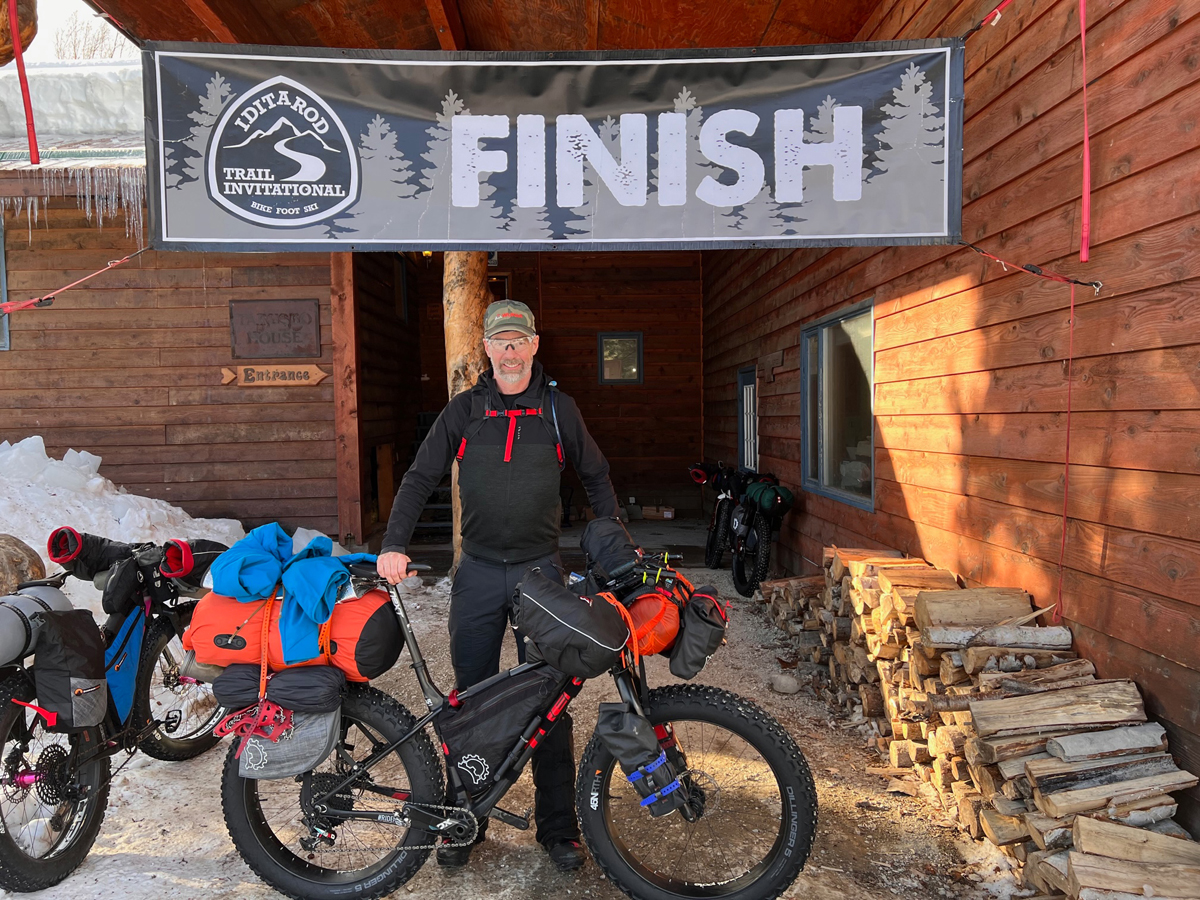
I made it to the finish in McGrath at 1:08pm. 4 days 22 hours and 45m after I left Knik. It was over. A year of planning, training, testing gear, over. I knew Suzanne was cheering in Salt Lake and that she probably got less sleep than I did these past few days. I would not have been able to do this without her support, I could not wait to get back to her. At the finish line, I was reunited with a lot of the folks I met along the trail. We spent the rest of the day and evening telling tales about our adventure and experience. It was a really special way to wrap things up.
When I started this, I had a performance goal in mind. I did not meet it. I have spent a lot of time thinking about it since the finish. Would going faster have made this a better experience? The answer is a hard NO? Ultimately, I went to Alaska to test myself, to find adventure. What place I got is not relevant. As a younger man I would have focused just on that and been pissed I didn’t get the place I wanted. That would have taken away from the sheer beauty of this event. I will always be a racer at heart, but I have to say that bikepacking and multi-day trips are something I never thought I would enjoy but now I am obsessed. That is the cool thing about bikes. Even after 30 years of riding I am still finding new things to do. Thanks for reading. Hopefully, this encourages you to find your own adventure.
Art O’Connor is the owner of WUKAR Fit (wukar.com), making stronger cyclists one rep at a time since 2012.

